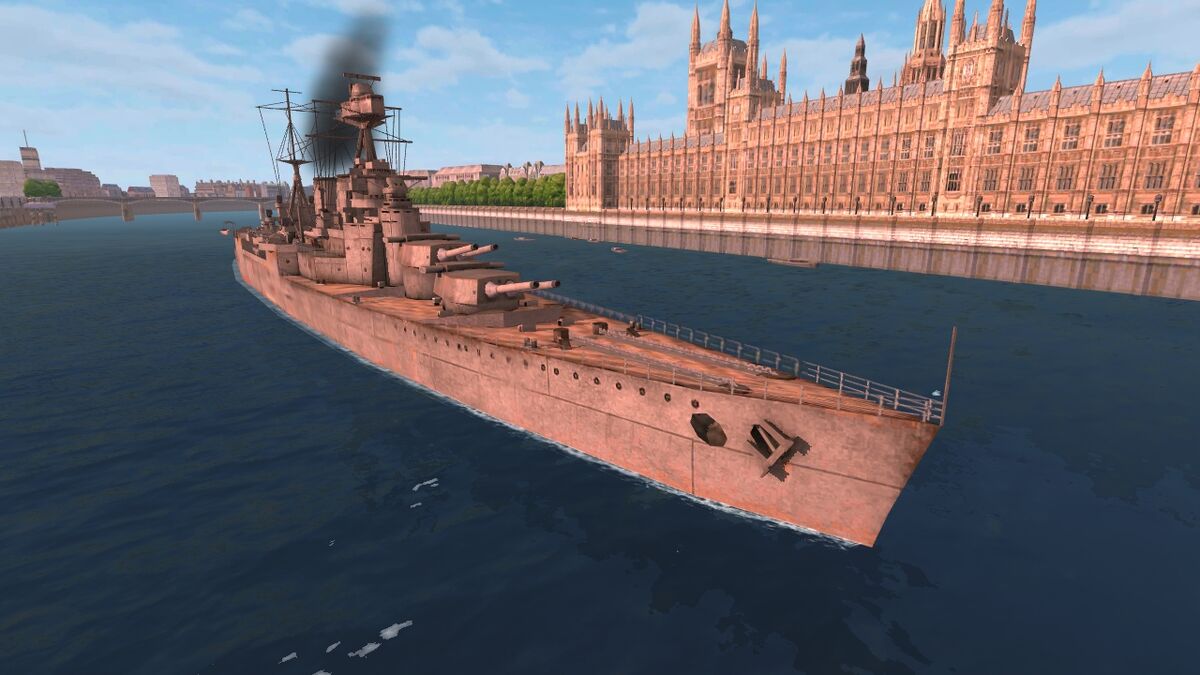Hms Hood Guns - This article is about the Admiral class battleship. For other ships of the same name, see List of ships named HMS Hood.
HMS Hood (No. 51) was a Royal Navy (RN) warship. Hood was the first of four Admiral-class fighters to be built during World War I. Still under construction, the Battle of Jutland in mid-1916 revealed serious flaws in her design, despite major revisions before the end of the battle. Because of this, she ended up being the only ship of her class, as the Admiralty decided it would be best to start with a pure design of successful battlecruisers, resulting in the never operational G-3 class. Despite her appearance as a new, modern ship, Hood remained the world's largest battleship for 20 years after entering service, and her reputation is reflected in her nickname "The Mighty Hood".
Hms Hood Guns

Hood in 2011. The year after the outbreak of the Second Italo-Ethiopian War in 1935, he went to the Mediterranean. The following year, when the Spanish Civil War broke out, Hood was officially assigned to the Mediterranean before returning to Britain for refit in 1939. By this time, advances in naval gunnery had reduced Hood's superiority. In order to rectify these issues, a major refit was planned in 1941, but the outbreak of World War II in September 1939 forced the ship into service without any improvements.
H.m.s. Hood Association Battle Cruiser Hood: H.m.s. Hood Today
When war with Germany was declared, Hood was operating in the Iceland area and spent the next few months hunting down German merchant pirates and blockade runners between Iceland and the Norwegian Sea. After completing part of her propulsion system, she sailed as the flagship of H Force and participated in the destruction of Fritz's fleet at Mers Al Kabir. Immediately after transfer to the Home Fleet, Hood was sent to Scapa Flow and acted locally as a convoy escort and later as a defense against the German invasion fleet.
In May 1941, Hood and the battleship Prince of Wales were ordered to intercept the German battleship Bismarck and the heavy cruiser Prince Eigg en route to the Atlantic. On 24 May 1941, at the start of the Battle of Dimarck Strait, Hood was hit by several German shells, exploded and sank, losing all but 3 of her 1,418 crew. The morale of the British was affected.
The RN conducted two inquiries due to the rapid disappearance of the vessel. The first, taken shortly after the ship was lost, concluded that the hood behind the magazine had exploded after one of Bismarck's shells had ricocheted off the ship's shield. The second question arose after the first panel complained about alternative explanations, such as a ship's torpedo explosion. It was more precise than the first panel but agreed with the conclusion of the first panel. Despite the official explanation, some historians still believe that a torpedo caused the ship's destruction, while others posit an accidental explosion in one of the ship's guns that reached the magazine. Other historians gathered because of the explosion of the magazine. In 2001, the discovery of the shipwreck meant the end of both boards.
The Admiral-class battlecruisers were designed as a response to the German Max-class cruisers, which were said to be more armored and armored than the more recent British Rowan and Brave classes. The design was modified to include heavier armament after the Battle of Jutland, where all four ships were deployed. Only Hood was completed because the ships were too complex and required the manpower and materials to make the most of the merchant ships needed to replace those lost in the German U-boat campaign.
World War Ii Hms Hood (2620 Pieces)
The admirals were much larger than the previous creditors of the rowan class. When completed, the hood had an overall draft of 860 ft 7 in (262.3 m), a maximum draft of 104 ft 2 in (31.8 m), and a draft of 32 ft (9.8 m) in deep load. The ship was 66 feet (20.1 m) longer and 14 feet (4.3 m) wider than the older ships. She displaced 42,670 long tons (43,350 t) in cargo and 46,680 long tons (47,430 t) in deep cargo, more than 13,000 long tons (13,210 t) more than the older ships. The ship had a 4.2-foot (1.3 m) long draft in the deep load, which reduced her rotation and gave her a permanent gun platform.
Additional armor added during construction increased her draft by 4 feet (1.2 m) at deep loading, which reduced her freeboard and made her very wet. At full speed, or in heavy seas, water flows over a quarter of the ship's deck, often washing the mess and living spaces in the glass shafts.
Constant humidity, combined with poor air pollution on board, is responsible for the high rate of tuberculosis on board.

The complement of wrestling varied greatly throughout his career. In 1919, 1433 meters was adopted as the regimental flag. In 1934, she had 81 officers and 1244 ranks.
Cleaning The Guns Of Hms 'hood'.
Admirals were powered by four modified Brown Curtis steam turbines, each driving a propeller shaft with steam from 24 Yarrow boilers. The cruiser's turbines were designed to produce 144,000 shaft horsepower (107,000 kW), propelling the ship at a speed of 31 knots (57 km/h; 36 km/h), but during sea trials in 1920, the hood turbines produced 1,511,280 shpt produced , 810 kW), which allowed her to reach a speed of 32.07 knots (59.39 km/h; 36.91 mph).
She carried enough fuel to give her a range of 7,500 nautical miles (13,900 km; 8,600 mi) at a speed of 14 knots (26 km/h; 16 mph).
The Admiral-class ships' main battery consisted of eight BL 15-inch (381 mm) Mk I guns in twin hydraulically powered gun turrets. Turrets are marked 'A', 'B', 'X' and 'Y' from bow to stern.
They are mounted on single-pillar fenders mounted on the upper deck and forward accommodation deck. This elevated position allowed them to operate in rough weather, as they were less affected by waves and spray than earlier British capital ships.
Remembering Hms Hood, The Mighty Warship Launched In Clydebank
Two of these guns were replaced by QF 4-inch (102 mm) Mk V (AA) anti-aircraft guns on the bunker deck between 1938 and 1939. All 5.5-inch guns were withdrawn again in 1940.
In 1926, Hudd, with a 15-inch gun alongside, rounded her starboard bow and covered the port bow. Shooting at this location can cause an explosion in the ship and superstructure
The ship's main anti-aircraft armament consisted of four QF 4-inch Mk V guns in single mounts. These are joined in early 1939 by four twin mounts for the dual-purpose 4-inch QF Mark XVI gun. The single guns were removed in mid-1939 and three more twin Mark XIX mounts were added in early 1940.

In 1931, a pair of octagonal mounts for the 40 mm (1.6 in) QF 2 lb Mk VIII "pom-pom" gun were added in the bunker floor, near the funnel, and a third mount was added in 1937. Two quad mounts were added in 1933 for the 0.5-inch (12.7 mm) Mk III Vickers machine gun. rockets (178 mm).
Qf 4 Inch Naval Gun Mk Xvi
When they exploded, the rockets ejected kilograms of cable held by parachutes. This cable was designed to grab the plane and remove the small air mine that would destroy the plane.
Admirals were fitted with six 21-inch (533 mm) vertical torpedo tubes on each broadside. Two of these were submerged in front of the 'A' turret magazine and the other four floated in the rear funnel.
The ship's main battery was under the control of two fire control directors. One was mounted atop the conning tower, protected by an armored hood, and equipped with a 30-foot (9.1 m) range finder. The other is mounted on a point on top of the front tripod and is equipped with a 15-foot (4.6 m) range finder. Each turret is also equipped with a 30-foot (9.1 m) range finder. The secondary armature is primarily controlled by conductors installed across each bridge. The 9-foot (2.7 m) rangefinders installed in 1924–1925 were equipped with two additional forward control positions.
The anti-aircraft guns were controlled by a simple 2 m (6 ft 7 in) high-angle seeker mounted on the muzzle control position.
Hms Hood 1937
Installed in 1926-1927. Three torpedo control towers, each with a 15-foot (4.6 m) range finder, were installed. One was in each ship's midships control tower and the third was on the aft line at the aft control position.
Aerial view of the abdomen
Hms hood model, 1 200 hms hood, airfix hms hood, hms hood battleship, hms hood sunk, hms victory guns, hms hood crew list, hood hms, hms hood model kit, cobi hms hood, hms hood 1 700, lego hms hood

0 Comments